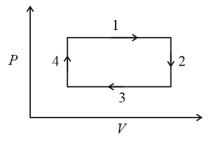EASY
Earn 100
The specific heat of a substance i.e at constant pressure is defined as the rate of change of _____ with respect to ______
(a)work, pressure
(b)enthalpy, temperature
(c)enthalpy, pressure
(d)heat, temperature
50% studentsanswered this correctly
Important Questions on Heat and Thermodynamics
EASY
MEDIUM
EASY
EASY
EASY
(Take gas constant )
EASY
MEDIUM
An ideal gas undergoes a four step cycle as shown in the diagram below. During this cycle, heat is absorbed by the gas in:

MEDIUM
MEDIUM
What will be the molar specific heat at constant volume of an ideal gas consisting of rigid diatomic molecules?
HARD
HARD
MEDIUM
[Given that
EASY
EASY
MEDIUM
MEDIUM
EASY
The molar heat capacity of oxygen gas at STP is nearly 2.5R. As the temperature is increased, it gradually increases and approaches 3.5 R. The most appropriate reason for this behaviour is that at high temperature
HARD
MEDIUM
MEDIUM

